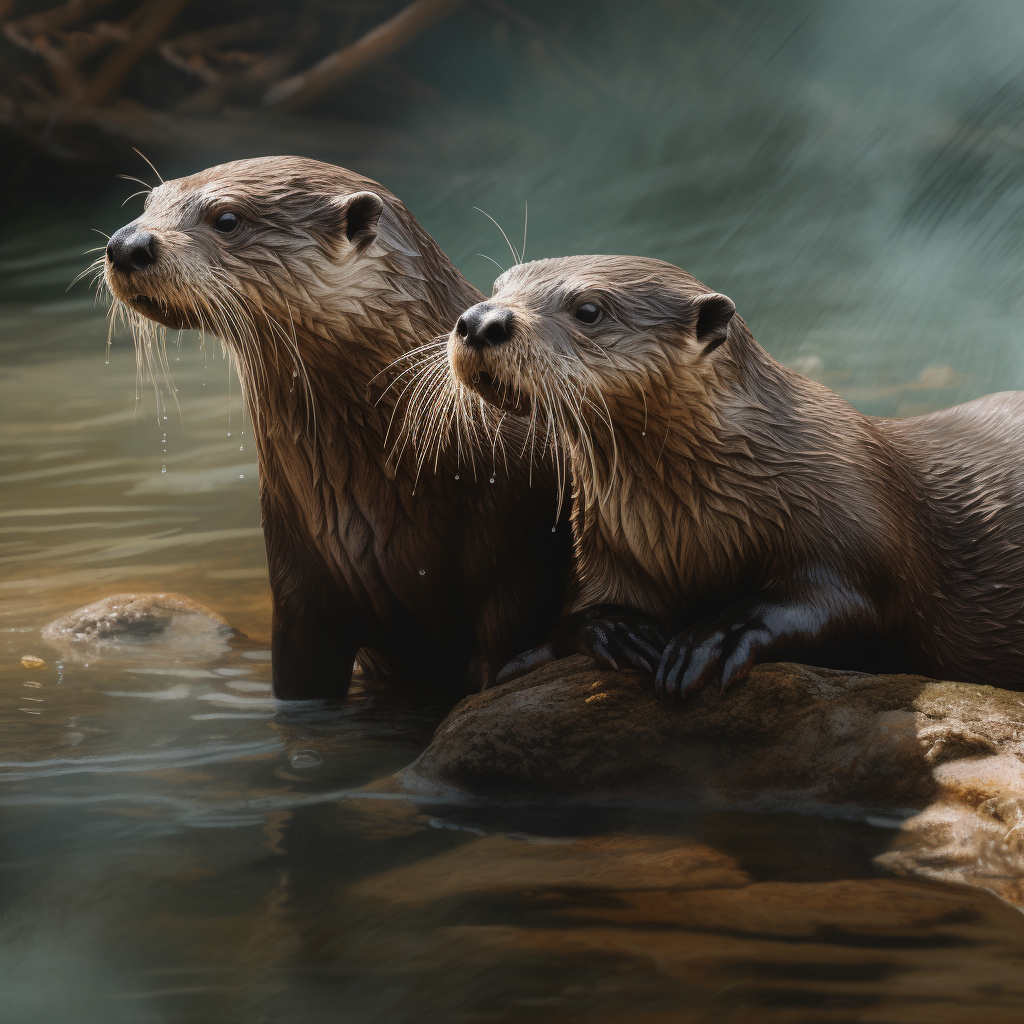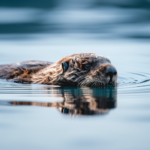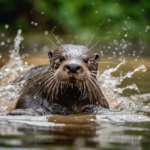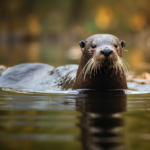River otters are fascinating creatures that inhabit freshwater ecosystems across North America, Europe, and Asia. These semi-aquatic mammals are known for their playful nature, sleek bodies, and webbed feet, which make them excellent swimmers. However, in recent years, concerns have been raised about the conservation status of river otters. This article aims to explore whether river otters are endangered, examining their population trends, threats they face, and conservation efforts in place to protect these charismatic animals. So, let’s dive in and learn more about the current status of river otters and what we can do to ensure their survival.
Key Takeaways
- River otters are not currently considered endangered.
- However, their populations have declined in some regions due to habitat loss and pollution.
- Conservation efforts are important to protect river otters and their habitats.
- Monitoring and research are necessary to ensure the long-term survival of river otter populations.
Understanding River Otters: A Brief Overview
River otters are fascinating creatures that inhabit various aquatic ecosystems across North America. In this section, we will explore the unique characteristics of river otters and delve into their habitat and distribution.
A. The Unique Characteristics of River Otters
River otters possess a set of remarkable adaptations that enable them to thrive in their watery habitats. Here are some key characteristics of these playful and agile creatures:
-
Sleek and Streamlined Body: River otters have long, slender bodies with short legs and webbed feet, making them excellent swimmers. Their streamlined shape allows them to glide effortlessly through the water, reaching speeds of up to 7 miles per hour.
-
Thick Fur Coat: River otters have dense, waterproof fur that helps insulate them in cold water. Their fur consists of two layers: a dense undercoat that traps air for insulation and longer guard hairs that repel water. This adaptation allows them to stay warm and dry, even in frigid temperatures.
-
Excellent Swimmers: River otters are highly skilled swimmers, thanks to their webbed feet and strong tails. They use their hind limbs and tail to propel themselves through the water with precision and agility. Their front paws are dexterous and can be used for grasping prey or manipulating objects.
-
Playful Nature: River otters are known for their playful behavior, often engaging in sliding, chasing, and wrestling games. These playful activities serve various purposes, including social bonding, practicing hunting techniques, and simply having fun.
-
Diet and Hunting: River otters are carnivorous and primarily feed on fish, amphibians, crustaceans, and small mammals. They are skilled hunters, using their acute sense of smell and excellent underwater vision to locate prey. River otters can hold their breath for several minutes while hunting underwater.
B. The Habitat and Distribution of River Otters
River otters are found in a variety of aquatic habitats, including rivers, lakes, marshes, and coastal areas. They are highly adaptable and can thrive in both freshwater and marine environments. Here are some key points about their habitat and distribution:
-
Geographical Range: River otters are native to North America and can be found throughout the continent. They inhabit regions from Alaska and Canada down to Mexico and parts of the southeastern United States.
-
Aquatic Ecosystems: River otters rely on healthy aquatic ecosystems for their survival. They prefer habitats with clean water, abundant prey, and suitable denning sites. These ecosystems include rivers, streams, lakes, and wetlands, which provide the necessary resources for their survival.
-
Habitat Loss: River otters face habitat loss and degradation due to human activities such as urbanization, agriculture, and dam construction. These factors can fragment their habitats, disrupt their movement patterns, and reduce the availability of suitable food sources.
-
Conservation Efforts: Recognizing the importance of river otters in maintaining ecosystem balance, various conservation organizations and government agencies have implemented measures to protect and restore their habitats. These efforts include habitat restoration projects, pollution control, and the establishment of protected areas.
-
Population Status: While river otters are not currently listed as endangered, their populations have faced declines in the past due to overhunting and habitat loss. However, conservation efforts and protective measures have helped stabilize their populations in many regions.
In conclusion, river otters are fascinating creatures with unique adaptations that allow them to thrive in aquatic environments. Understanding their characteristics, habitat, and distribution is crucial for their conservation and the preservation of their ecosystems. By protecting their habitats and implementing sustainable practices, we can ensure the continued survival of these charismatic animals for future generations to enjoy.
The Status of River Otters: Are They Endangered?

A. The Plight of Southern River Otters
Southern river otters, also known as neotropical otters, are facing significant challenges in their natural habitats. These otters are found in Central and South America, and their populations have been declining due to various factors.
One of the major threats to southern river otters is habitat loss. Deforestation and the conversion of their natural habitats into agricultural land have greatly reduced the available space for these otters to thrive. As their habitats shrink, the otters are forced to compete for resources and face increased vulnerability to predation.
Another issue affecting southern river otters is pollution. Industrial activities and agricultural runoff introduce harmful substances into the waterways, which can have detrimental effects on the otters’ health. Pollutants can accumulate in their bodies, leading to reproductive problems and weakened immune systems.
Furthermore, southern river otters are often hunted for their fur. Despite legal protections in some countries, illegal hunting continues to pose a threat to their survival. The demand for otter pelts in the fur trade industry puts additional pressure on their populations.
B. The Struggle of Giant River Otters
Giant river otters are the largest otter species in the world, and they inhabit the rivers and wetlands of South America. Despite their size and strength, these otters are also facing significant challenges that have led to their endangered status.
Habitat destruction is a major concern for giant river otters. The conversion of their natural habitats for agriculture, logging, and infrastructure development has fragmented their populations and limited their access to suitable habitats. This fragmentation makes it difficult for otters to find mates and establish stable territories.
Additionally, pollution poses a serious threat to giant river otters. Industrial activities, mining operations, and agricultural practices contribute to water pollution, affecting the otters’ food sources and overall health. Contaminated water can lead to the accumulation of toxins in their bodies, causing reproductive issues and compromising their immune systems.
Giant river otters are also vulnerable to overfishing. As their prey species decline due to unsustainable fishing practices, the otters struggle to find enough food to sustain themselves and their young. This scarcity of prey further exacerbates the challenges they face in their already compromised habitats.
C. The Situation of North American River Otters
North American river otters, also known as common otters, have a relatively stable population compared to their southern and giant counterparts. However, they still face threats that could impact their long-term survival.
Habitat loss and degradation are significant concerns for North American river otters. Urbanization, agriculture, and the construction of dams have altered their natural habitats, reducing the availability of suitable areas for these otters to live and breed. The fragmentation of their habitats can isolate populations and limit gene flow, potentially leading to genetic issues and decreased resilience.
Pollution, particularly from industrial and agricultural sources, also affects North American river otters. Contaminants in the water can accumulate in their bodies, causing health problems and reproductive issues. Additionally, pollution can reduce the availability of prey species, further impacting the otters’ ability to find sufficient food.
Despite these challenges, North American river otters have benefited from conservation efforts and legal protections. These measures have helped stabilize their populations and ensure their continued presence in many regions. However, ongoing monitoring and conservation initiatives are necessary to maintain their numbers and protect their habitats.
D. The Condition of River Otters in Texas and Florida
In Texas and Florida, river otters face unique challenges specific to these regions. While the overall populations of river otters in these states are relatively stable, certain factors pose risks to their survival.
In Texas, habitat loss and degradation are significant concerns for river otters. Urban expansion, agricultural activities, and the alteration of waterways have impacted their natural habitats. The loss of wetlands and the fragmentation of river systems can limit the available space for otters to establish territories and find suitable den sites.
Florida’s river otters, on the other hand, face additional threats from human activities. The state’s growing population and tourism industry put pressure on the otters’ habitats. Increased boat traffic and water pollution can disrupt their natural behaviors and impact their ability to find food. Furthermore, interactions with humans, such as accidental entanglement in fishing gear or vehicle collisions, can result in injuries or fatalities.
Efforts are underway in both Texas and Florida to protect and conserve river otters. Conservation organizations work to raise awareness about the importance of otter habitats and implement measures to mitigate the threats they face. These include habitat restoration projects, public education campaigns, and the enforcement of regulations to prevent illegal hunting or trapping.
Overall, while river otters face various challenges across different regions, concerted conservation efforts and public awareness can help ensure their survival. Protecting their habitats, reducing pollution, and implementing sustainable practices are crucial steps in safeguarding these charismatic and important members of our aquatic ecosystems.
The Reasons Behind the Endangerment of River Otters

A. Why Are Southern River Otters Endangered?
Southern river otters, also known as Neotropical otters, are facing endangerment due to several factors. One of the primary reasons is habitat loss. As human populations expand and encroach upon natural areas, the otters’ habitats are being destroyed or fragmented. This loss of suitable habitat limits their ability to find food, establish territories, and reproduce.
Another significant threat to southern river otters is pollution. Industrial activities, agriculture, and urban development contribute to the contamination of water bodies with chemicals and toxins. These pollutants accumulate in the otters’ prey, such as fish and crustaceans, and can lead to serious health issues and reproductive problems.
Furthermore, illegal hunting and poaching pose a significant threat to the survival of southern river otters. These otters are often targeted for their fur, which is highly valued in the illegal wildlife trade. The demand for otter pelts puts immense pressure on their populations, pushing them towards endangerment.
B. Why Are Giant River Otters Endangered?
Giant river otters, also known as the Pteronura brasiliensis, are the largest otter species in the world. Despite their size, they too face endangerment. One of the main reasons for their decline is habitat destruction. The destruction of their natural habitats, such as wetlands and riverside forests, disrupts their ability to find suitable denning sites and access food sources.
Another significant factor contributing to the endangerment of giant river otters is the pollution of their aquatic ecosystems. Industrial pollution, mining activities, and agricultural runoff introduce harmful chemicals and pollutants into the water, affecting the otters’ health and the availability of their prey.
Additionally, overfishing and depletion of fish populations have a direct impact on the survival of giant river otters. These otters rely heavily on fish as their primary food source, and when fish populations decline, it becomes increasingly challenging for them to find enough food to sustain themselves and their offspring.
C. Why Are North American River Otters Endangered?
North American river otters, also known as Lontra canadensis, are facing endangerment due to various factors. One of the significant threats they face is habitat loss and degradation. Urban development, deforestation, and the alteration of waterways disrupt the otters’ natural habitats, limiting their access to suitable denning sites and reducing the availability of prey.
Pollution is another significant concern for North American river otters. Chemical pollutants, such as pesticides and heavy metals, contaminate the water bodies in which they live and the fish they rely on for sustenance. These pollutants can accumulate in the otters’ bodies, leading to health issues and reproductive problems.
Furthermore, the impact of climate change poses additional challenges for North American river otters. Rising temperatures, altered precipitation patterns, and changing river flows can disrupt the otters’ ability to find food and establish territories. Climate change also affects the availability of ice, which otters use for resting and hunting.
In conclusion, river otters, including southern river otters, giant river otters, and North American river otters, face endangerment due to habitat loss, pollution, hunting, and climate change. Protecting and conserving these charismatic creatures is crucial not only for their survival but also for maintaining the balance of aquatic ecosystems and preserving biodiversity. Efforts to mitigate these threats and implement conservation measures are essential to ensure the long-term survival of river otter populations.
The Impact of River Otters’ Endangerment on Ecosystems

A. The Role of River Otters in Ecosystems
River otters play a crucial role in maintaining the balance and health of aquatic ecosystems. As skilled predators, they help control the population of various species, ensuring that the ecosystem remains in equilibrium. Let’s take a closer look at the important roles river otters play in their habitats:
-
Predator Control: River otters primarily feed on fish, amphibians, and invertebrates. By preying on these animals, otters help regulate their populations, preventing any one species from becoming too dominant. This, in turn, promotes biodiversity and ensures a healthy ecosystem.
-
Nutrient Cycling: River otters consume a significant amount of prey, and their scat, or droppings, contain nutrients that are essential for the growth of aquatic plants. When otters defecate in or near water bodies, these nutrients are released, enriching the surrounding environment and supporting the growth of various organisms.
-
Habitat Engineering: Otters create dens along riverbanks, which serve as shelter for themselves and other species. These dens also help stabilize the riverbanks, preventing erosion and maintaining the integrity of the surrounding habitat.
-
Indicator Species: River otters are considered indicator species, meaning their presence or absence can indicate the overall health of an ecosystem. If otters are thriving, it suggests that the ecosystem is functioning well. Conversely, a decline in otter populations may indicate environmental degradation or the presence of pollutants.
B. The Consequences of Losing River Otters
The endangerment of river otters can have far-reaching consequences for both the ecosystem and other species that depend on them. Here are some potential consequences of losing river otters:
-
Disruption of Food Chains: As top predators, river otters help regulate the populations of their prey. If otters were to disappear, certain prey species could experience population explosions, leading to imbalances within the food chain. This could result in overgrazing of vegetation, depletion of certain fish populations, and cascading effects throughout the ecosystem.
-
Loss of Biodiversity: River otters contribute to the overall biodiversity of their habitats. Their absence could lead to a decline in the diversity of aquatic species, as well as a loss of genetic diversity within populations. This reduction in biodiversity can weaken the resilience of ecosystems, making them more susceptible to disturbances and less able to adapt to changing conditions.
-
Decreased Water Quality: River otters are highly sensitive to pollution, particularly from contaminants such as heavy metals and pesticides. Their decline can serve as an indicator of deteriorating water quality. Without otters to help regulate prey populations, certain species may become more abundant and contribute to increased nutrient runoff, leading to eutrophication and reduced water quality.
-
Loss of Ecotourism Opportunities: River otters are charismatic animals that attract ecotourism, benefiting local economies. Their presence in rivers and wetlands can draw visitors who appreciate the beauty and diversity of these habitats. If otters were to disappear, it could have negative economic impacts on communities that rely on ecotourism.
In conclusion, the endangerment of river otters poses significant risks to aquatic ecosystems. These animals play vital roles in maintaining the balance of their habitats, and their loss can have far-reaching consequences. Protecting and conserving river otters is not only crucial for their survival but also for the health and resilience of the ecosystems they inhabit.
The Current Conservation Efforts for River Otters
River otters are fascinating creatures that play a vital role in maintaining the health and balance of aquatic ecosystems. However, due to various environmental threats, their populations have been declining in recent years. To combat this decline and protect these remarkable animals, numerous conservation efforts have been implemented worldwide. Let’s take a closer look at some of the measures taken to safeguard river otters in different regions.
A. Measures Taken to Protect Southern River Otters
Southern river otters, also known as Neotropical otters, are found in Central and South America. These otters face significant challenges due to habitat loss and degradation caused by deforestation, pollution, and human encroachment. To address these issues, several initiatives have been put in place.
-
Habitat Restoration: Efforts are being made to restore and protect the natural habitats of southern river otters. This includes reforestation projects and the establishment of protected areas where otters can thrive undisturbed.
-
Pollution Control: Pollution, particularly from agricultural runoff and industrial waste, poses a significant threat to otters and their habitats. To mitigate this, stricter regulations and monitoring systems have been implemented to reduce pollution levels and ensure the waterways remain clean and safe for otters.
-
Community Education: Raising awareness among local communities about the importance of conserving southern river otters is crucial. Educational programs and workshops are being conducted to promote responsible fishing practices and discourage activities that harm otters and their habitats.
B. Initiatives for the Conservation of Giant River Otters
Giant river otters, the largest of all otter species, are primarily found in the Amazon basin. These charismatic creatures are highly endangered due to habitat destruction, illegal hunting, and the pet trade. To protect them, various initiatives have been undertaken.
-
Protected Areas: Establishing protected areas, such as national parks and reserves, is vital for the conservation of giant river otters. These areas provide a safe haven for the otters and help preserve their natural habitats.
-
Anti-Poaching Efforts: Illegal hunting and the capture of giant river otters for the pet trade are major threats to their survival. Anti-poaching units and increased law enforcement efforts are being implemented to combat these activities and protect the otters from harm.
-
Research and Monitoring: Conducting research and monitoring programs is essential to gather data on the population size, behavior, and habitat requirements of giant river otters. This information helps inform conservation strategies and ensures effective management of their habitats.
C. Actions to Save North American River Otters
North American river otters, also known as common otters, are found throughout the United States and Canada. While their populations have rebounded in some areas, they still face challenges due to habitat loss, pollution, and climate change. Several actions are being taken to safeguard these otters.
-
Habitat Protection: Preserving and restoring the habitats of North American river otters is crucial for their survival. This includes conserving wetlands, riparian areas, and other aquatic ecosystems that serve as their homes.
-
Pollution Mitigation: Pollution from industrial and agricultural sources can have detrimental effects on otters and their prey. Efforts are being made to reduce pollution levels and improve water quality through stricter regulations and pollution control measures.
-
Climate Change Adaptation: Climate change poses a significant threat to North American river otters, as it alters their habitats and affects their food sources. Conservation organizations are working to develop strategies that help otters adapt to changing environmental conditions and ensure their long-term survival.
In conclusion, the conservation efforts for river otters are essential for protecting these remarkable creatures and maintaining the biodiversity of our aquatic ecosystems. By implementing measures to protect their habitats, combat pollution, and address the impacts of climate change, we can secure a brighter future for river otters and ensure their continued presence in our natural world.
Are River Otters Dangerous: Debunking Myths
A. Understanding the Behavior of River Otters
River otters are fascinating creatures that inhabit various aquatic ecosystems across North America. To better understand whether they are dangerous, it is essential to delve into their behavior. River otters are known for their playful nature and social behavior. They are highly adaptable and can thrive in a wide range of habitats, including rivers, lakes, marshes, and coastal areas.
These semi-aquatic mammals are excellent swimmers, thanks to their streamlined bodies, webbed feet, and muscular tails. They spend a significant amount of time in the water, where they hunt for fish, crayfish, amphibians, and other small aquatic animals. River otters are skilled hunters and have a diverse diet, which helps maintain the balance of aquatic ecosystems.
River otters are primarily diurnal, meaning they are most active during the day. They are highly social animals and often live in family groups called “rafts.” These rafts consist of an adult breeding pair and their offspring. River otters communicate through a variety of vocalizations, including chirps, growls, and whistles, as well as through scent marking.
B. The Misconceptions about River Otters
Despite their playful and social nature, river otters have been subject to various misconceptions that have led to the belief that they are dangerous. Let’s debunk some of these myths:
-
River Otters Attack Humans: River otters are generally not aggressive towards humans. They prefer to avoid human contact and will usually retreat if they sense humans nearby. However, like any wild animal, they may become defensive if they feel threatened or cornered. It is important to respect their space and observe them from a distance.
-
River Otters Pose a Threat to Pets: While river otters are known to be curious, they do not typically pose a threat to well-behaved pets. However, it is advisable to keep pets on a leash when near water bodies to prevent any potential conflicts.
-
River Otters Transmit Diseases: River otters, like any wild animal, can carry diseases. However, the risk of transmission to humans is minimal if proper precautions are taken. Avoid direct contact with river otters, their feces, or urine, and maintain good hygiene practices when in their habitat.
-
River Otters Damage Property: River otters may occasionally cause damage to property, such as fish ponds or aquaculture facilities, in their search for food. However, these instances are relatively rare, and preventive measures can be taken to minimize any potential damage.
It is crucial to dispel these misconceptions and promote a better understanding of river otters. These charismatic creatures play a vital role in maintaining the health of aquatic ecosystems and should be appreciated and protected.
In conclusion, river otters are not inherently dangerous to humans or pets. By understanding their behavior and debunking the myths surrounding them, we can foster a greater appreciation for these remarkable animals and work towards their conservation and the preservation of their habitats.
The Future of River Otters: Are They Going Extinct?
A. The Projections for Southern River Otters
Southern river otters, also known as Neotropical otters, are found in Central and South America. These adorable creatures are well-adapted to their aquatic habitats, with their streamlined bodies and webbed feet allowing them to swim effortlessly. However, like many other species, southern river otters face several threats that could impact their future survival.
One of the main concerns for southern river otters is habitat loss. As human populations expand and encroach upon their natural habitats, these otters are losing their homes. Deforestation, urbanization, and the construction of dams all contribute to the destruction of their habitats. This loss of habitat not only affects the otters directly but also disrupts the delicate balance of aquatic ecosystems they rely on.
Another significant threat to southern river otters is pollution. Industrial and agricultural activities release harmful chemicals into rivers and water bodies, contaminating the otters’ food sources and causing long-term damage to their health. Additionally, the accumulation of pollutants in their bodies can lead to reproductive issues and weakened immune systems, making them more susceptible to diseases.
Conservation efforts are crucial for the future of southern river otters. Protecting their habitats, implementing stricter pollution control measures, and raising awareness about the importance of these creatures are essential steps in ensuring their survival. By working together, we can help secure a brighter future for southern river otters.
B. The Predictions for Giant River Otters
Giant river otters, also known as the Pteronura brasiliensis, are the largest otter species in the world. These magnificent creatures can grow up to six feet long and are known for their playful nature and unique vocalizations. However, despite their impressive size and captivating presence, giant river otters are facing numerous challenges that threaten their existence.
Habitat destruction is a significant concern for giant river otters. As their name suggests, these otters inhabit the rivers and wetlands of South America. However, deforestation, mining, and the expansion of agriculture are rapidly encroaching upon their habitats. The loss of these vital ecosystems not only displaces the otters but also disrupts the delicate balance of the aquatic ecosystems they rely on for food and shelter.
Illegal hunting and poaching are also significant threats to giant river otters. Their luxurious fur and perceived medicinal properties make them targets for illegal wildlife trade. Despite legal protection in many countries, the demand for their pelts persists, putting these otters at risk of being hunted to extinction.
Conservation efforts are crucial for the survival of giant river otters. Efforts to protect their habitats, enforce anti-poaching laws, and raise awareness about the importance of these magnificent creatures are essential. By supporting organizations dedicated to their conservation and promoting sustainable practices, we can help secure a future where giant river otters thrive.
C. The Forecasts for North American River Otters
North American river otters, also known as Lontra canadensis, are native to the rivers, lakes, and coastal areas of North America. These playful and charismatic otters are well-adapted to their aquatic habitats, with their dense fur and webbed feet allowing them to swim and dive with ease. While they are currently not considered endangered, there are still concerns about their future.
One of the main threats to North American river otters is habitat loss. Urbanization, agriculture, and the construction of dams have resulted in the degradation and fragmentation of their habitats. This loss of suitable habitat can lead to population declines and limit their ability to find food and establish territories.
Pollution is another significant concern for North American river otters. Runoff from agricultural lands and industrial activities introduces harmful chemicals into their habitats, contaminating their food sources and affecting their overall health. Additionally, the accumulation of pollutants in their bodies can have long-term effects on their reproductive capabilities and immune systems.
Climate change is also a growing threat to North American river otters. Rising temperatures, altered precipitation patterns, and sea-level rise can all impact their habitats and prey availability. Changes in water temperature and quality can also affect their ability to find food and navigate their environments.
To ensure the future of North American river otters, conservation efforts must focus on protecting and restoring their habitats, reducing pollution, and addressing the impacts of climate change. By implementing measures to mitigate these threats and promoting responsible stewardship of our natural resources, we can help secure a thriving future for North American river otters.
In conclusion, the future of river otters is at a critical juncture. The projections for southern river otters, predictions for giant river otters, and forecasts for North American river otters all highlight the urgent need for conservation efforts. By addressing habitat loss, pollution, illegal hunting, and the impacts of climate change, we can ensure the survival of these remarkable creatures and maintain the biodiversity and balance of our aquatic ecosystems. It is up to us to take action and protect the future of river otters for generations to come. Conclusion
In conclusion, while river otters were once on the brink of extinction due to habitat loss and pollution, conservation efforts have helped to stabilize their populations. Today, river otters are not considered to be endangered, but they still face threats from habitat destruction, pollution, and climate change. It is important for us to continue to protect and preserve their habitats, as well as raise awareness about the importance of these charismatic creatures. By working together, we can ensure that river otters continue to thrive in our rivers and bring joy to future generations.
Frequently Asked Questions
Q1: Why are Southern River Otters endangered?
Southern River Otters are endangered due to a variety of factors. The primary reasons include habitat loss, pollution, and hunting. Their habitats are often destroyed for agricultural and industrial development, while pollution from these activities can also contaminate the aquatic ecosystems they live in. Hunting for their fur has also led to a significant decline in their population.
Q2: Are River Otters endangered species?
Yes, certain species of River Otters are considered endangered. This includes the Southern River Otter and the Giant River Otter. The endangerment status is due to factors such as habitat loss, hunting, and pollution.
Q3: Why are Giant River Otters endangered?
Giant River Otters are endangered due to a combination of habitat loss, hunting, and pollution. Their habitats are often destroyed for agricultural and industrial development, and they are hunted for their pelts. Additionally, pollution from these activities can contaminate the aquatic ecosystems they rely on.
Q4: How are River Otters endangered?
River Otters are endangered due to a combination of factors including habitat loss, hunting, and pollution. Their habitats are often destroyed for agricultural and industrial development, and they are hunted for their fur. Additionally, pollution from these activities can contaminate the aquatic ecosystems they rely on.
Q5: Are River Otters endangered in Texas?
The North American River Otter, which is found in Texas, is not currently listed as endangered. However, their populations have been impacted by habitat loss, pollution, and hunting, leading to a decline in some areas.
Q6: Are River Otters dangerous?
River Otters are not typically dangerous to humans unless provoked. They are generally shy and will avoid human contact. However, they are wild animals and can be aggressive if they feel threatened.
Q7: Are North American River Otters endangered?
The North American River Otter is not currently listed as endangered, but their populations have been impacted by habitat loss, pollution, and hunting. Conservation efforts are in place to protect and rehabilitate these otters.
Q8: Are River Otters threatened?
While not all species of River Otters are considered endangered, many are threatened due to factors such as habitat loss, hunting, and pollution. This includes the Southern River Otter and the Giant River Otter.
Q9: Are Florida River Otters endangered?
The North American River Otter, which includes the population in Florida, is not currently listed as endangered. However, their populations have been impacted by habitat loss, pollution, and hunting.
Q10: Are River Otters going extinct?
While some species of River Otters are endangered, they are not currently going extinct. Conservation efforts are in place to protect and rehabilitate these otters, and to preserve their habitats. However, ongoing threats such as habitat loss, hunting, and pollution continue to pose challenges to their survival.




